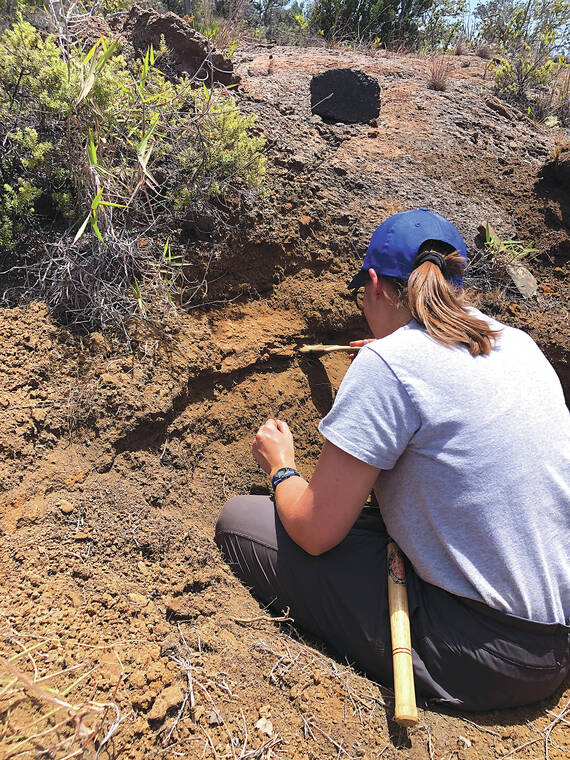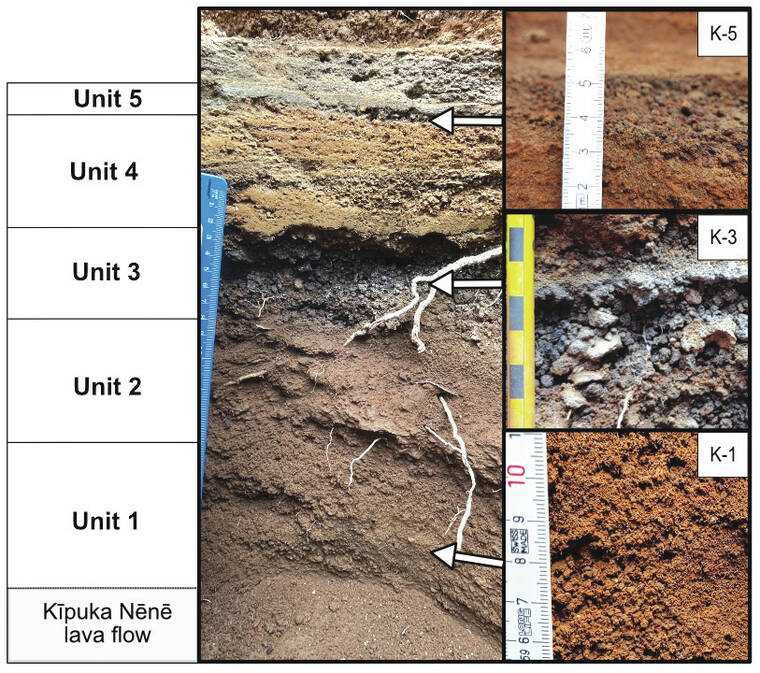Volcano Watch: What do we know about the Kulanaokuaiki Tephra of Kilauea volcano?

A paint brush is very useful to discern individual Kulanaokuaiki Tephra units by clearing away overlying younger ash and Pele's hair. At this field site on the south flank of Kilauea, the Kulanaokuaiki Tephra is overlain by Observatory Shield lava flows and underlain by the Kipuka Nene lava flows. This helps give great time constraints to the deposition of this tephra. (Kendra J. Lynn/USGS)

Stratigraphic column of the Kulanaokuaiki Tephra sequence, and an in-the-field look at this section with closer photographs of subunits K-1, K-3, and K-5. At some localities, there are interbedded lava flows that help correlate units across larger distances on Kilauea volcano. (Abigail Nalesnik/USGS)
Kilauea’s recent summit eruptions and lava lakes are exciting for residents, visitors, and scientists. However, Kilauea has had numerous explosive eruptions in the last 2,000 years that remain poorly understood.
Kilauea’s recent summit eruptions and lava lakes are exciting for residents, visitors, and scientists. However, Kilauea has had numerous explosive eruptions in the last 2,000 years that remain poorly understood.
My work has been focused on finding and sampling parts of the Kulanaokuaiki Tephra, which erupted from Kilauea 1,000-1,600 years ago (400-1000 CE).
ADVERTISING
The Kulanaokuaiki Tephra is part of the Uekahuna Ash, and it has been best studied on the south flank of Kilauea. Five stratigraphically distinct subunits, K-1 through K-5, make up the Kulanaokuaiki Tephra. All of them are composed of tephra — rock pieces ejected from a vent during explosive volcanic eruptions.
After they are ejected from the vent, tephra travel through the air for a distance; where they fall is determined in part by their shape and mass. These particles may travel far when a large explosive eruption has a plume high enough to reach trade wind and even jet stream heights. The plume that produced some of the Kulanaokuaiki Tephra deposits on the south flank of Kilauea is estimated to have reached 9-11 miles (14-18 km) high!
I am studying the Kulanaokuaiki Tephra deposits to learn more about where the tephra settled, how the eruptions happened and what the physical properties of the tephra itself can share about magmatic processes. It’s important to study a tephra unit with primary deposition, meaning that the deposit appears exactly as it was originally deposited.
Let’s examine the typical sequence of Kulanaokuaiki Tephra from the bottom (the first eruptions) to the top (the last eruptions). K-1 is usually the thickest of the units and is commonly found resting on the Kipukanene lava flow field (350-190 BCE). It is made up of small 0.2-0.4 inch (0.5-1 centimeter) pumice from high lava fountains that lofted this lighter material for several miles (kilometers).
K-2 is reworked and appears similar to K-1 but is chemically distinct making it useful as a geochemical marker between field sites.
There is a stark color and grain size change in K-3. It’s mostly made up of dark scoria ranging from less than 0.04 inches (1 millimeter) to over 1.2 inches (3 centimeters) in size. K-3 is a loose deposit and if I poked an exposure of it with a paint brush, pieces quickly fall out of the outcrop. I sub-sample K-1 and K-3 at several localities, which will be useful to explore the properties of each unit from beginning to end.
K-4 is a bright orange, fine grained layer that feels like cement when trying to dig into it. You certainly know it when it is present, so like K-2, it is a useful marker in the stratigraphy.
Lastly, K-5 is a scattered scoria deposit. It’s not always present but it begins poking out when you dig down from the top to sample. It can sometimes also be found embedded in the top of K-4!
During my ventures on Kilauea’s south flank, I’ve found that the thickness of subunits K-2 and K-4 are variable over short distances and are typically thicker in low-lying areas. Does this mean that more tephra truly fell in these localized areas (unlikely), or was some of it moved by wind or water in a process known as reworking?
We ask these questions because explosive eruptions like those that generated the Kulanaokuaiki Tephra have never been seen in the modern era at Kilauea, so only their primary deposits can give us clues. The variable thickness of K-2 and K-4 suggests that the deposit was reworked, so my study of the Kulanaokuaiki eruptions focuses on units K-1, K-3, and K-5.
Farther down Kilauea’s south flank, the Kulanaokuaiki Tephra deposit quickly changes. K-5 disappears, lost in the weeds of the soil and local vegetation. The bright orange K-4 becomes thinner, and the grains of K-3 become smaller. The once-abundant K-1 also disappears, as we are farther from the assumed source area of the summit. As I follow these units to the coast, the only remaining discernible unit is K-3. This part of the deposit made it all the way to Halape and beyond, ultimately settling in the ocean.
After making observations and sampling the Kulanaokuaiki Tephra deposit in the field, I’ll begin the work of analyzing samples in the USGS Hawaiian Volcano Observatory’s new state-of-the-art lab. My work will help to better interpret the explosive eruptions that produced the Kulanaokuaiki Tephra, giving us more insight into Kilauea’s eruptive processes over time.
Volcano activity updates
Kilauea is not erupting. Its USGS Volcano Alert level is ADVISORY.
The Kilauea summit eruption that began on Sept. 10 stopped on Sept. 16. Summit seismicity has remained low, with very few earthquakes over the past week, and tremor is at background levels. Summit tilt showed a couple of deflation and inflation cycles (DI-events) over the past week, with several microradians of net inflation. The most recent sulfur dioxide (SO2) emission rate, of approximately 150 tonnes per day, was measured on September 25.
Mauna Loa is not erupting. Its USGS Volcano Alert Level is at NORMAL.
Webcams show no signs of activity on Mauna Loa. Seismicity remains low. Summit ground deformation rates indicate slow inflation as magma replenishes the reservoir system following the recent eruption. SO2 emission rates are at background levels.
No earthquakes were reported felt in the Hawaiian Islands during the past week.
HVO continues to closely monitor Kilauea and Mauna Loa.
Please visit HVO’s website for past Volcano Watch articles, volcano photos, maps, recent earthquake information, and more. Email questions to askHVO@usgs.gov.


